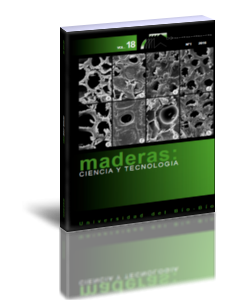Optimization of termite in-ground monitoring stations: An evaluation trial
Keywords:
Cellulosic matrix, Hevea brasiliensis, Populus sp., Reticulitermes grassei, subterranean termites, termite monitoring stations.Abstract
Subterranean termites are serious pests of wood in service in much of the world. One of the most popular techniques for monitoring and controlling termites is the use of in-ground monitoring stations. Different cellulosic matrices were evaluated in terms of mass loss, moisture content variation andtermite presence, accounting for spatial coordinates and monitoring station conditional variables, including: type of cellulosic matrix, matrix treatment and meteorological conditions, during one year in field conditions, both in Portugal and in the USA. A multivariate redundancy analysis was
performed resulting in 60.4% of data variability being explained by the variables considered in this analysis. Spatial variables were responsible for the highest amount of variance observed in the response variables monitored for the termite monitoring stations, followed by the type of cellulosic matrix,
from which cellulose and Hevea brasiliensis were the most influential variables. The optimization of termite in-ground monitoring stations should be performed through correct evaluation of termite feeding preferences and decay resistance, in order to choose an adequate bait matrix and a proper bait
design. The termite species biology and the geographical location where control programs will be applied should also be taken into account.
Downloads
Download data is not yet available.
Downloads
How to Cite
Duarte, S., M. Taylor, A., D. Lloyd, J., Duarte, M., & Nunes, L. (2016). Optimization of termite in-ground monitoring stations: An evaluation trial. Maderas. Ciencia Y Tecnología, 18(1), 191–206. Retrieved from https://revistas.ubiobio.cl/index.php/MCT/article/view/2251
Issue
Section
Article

































